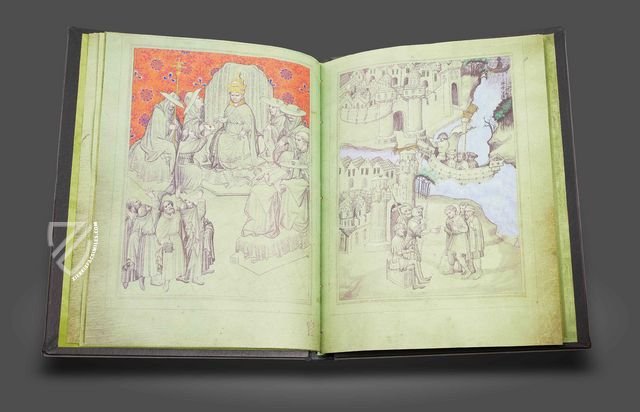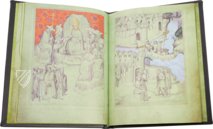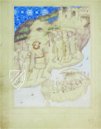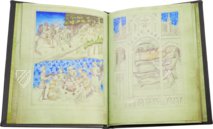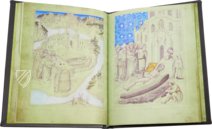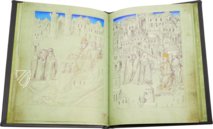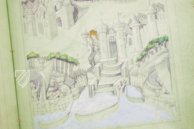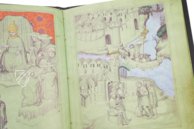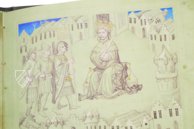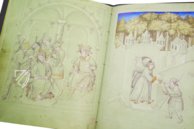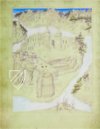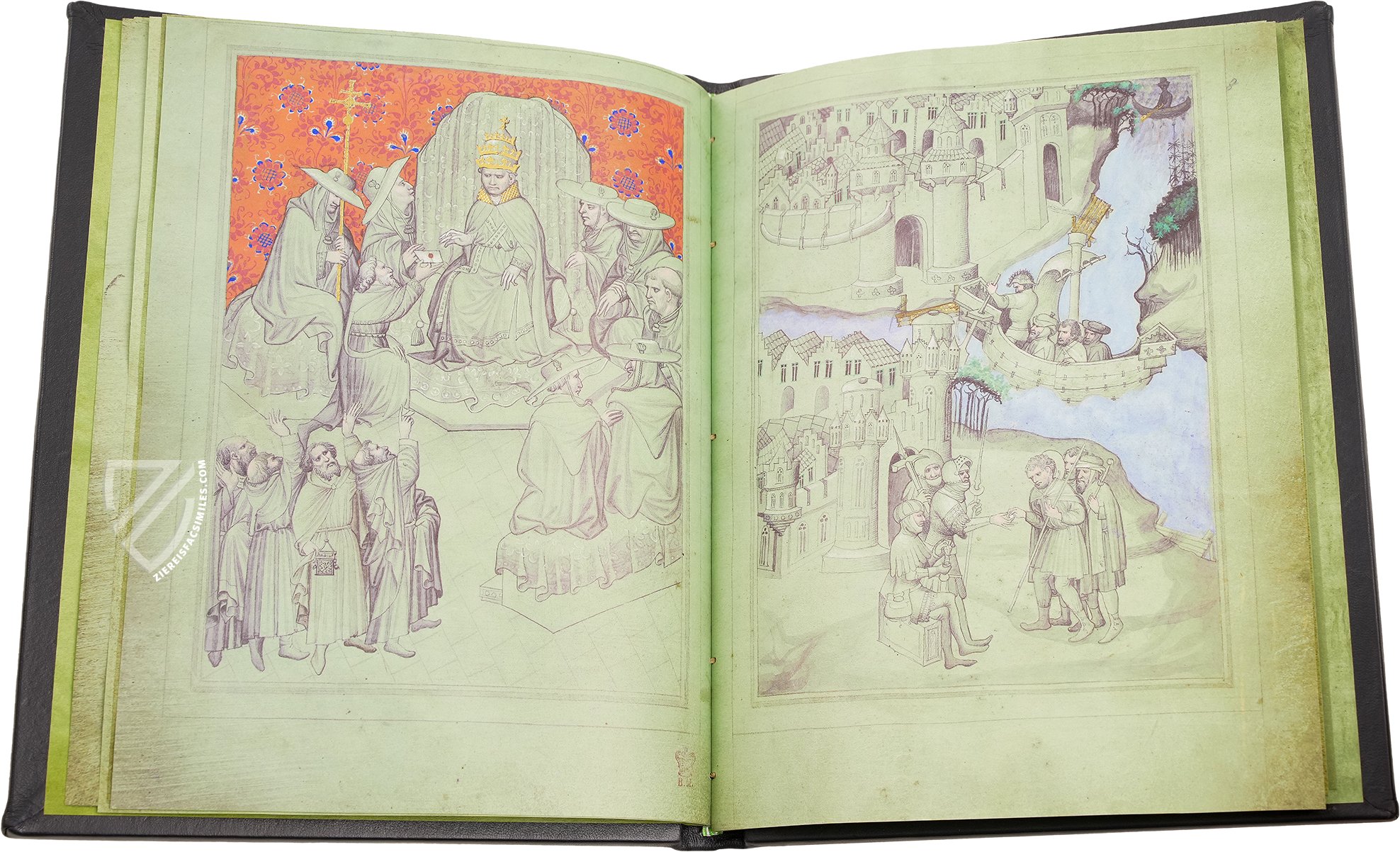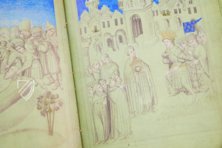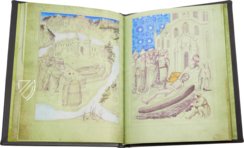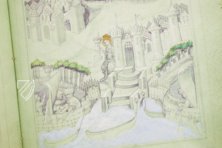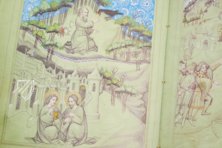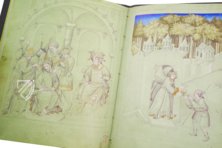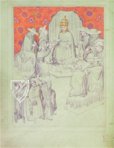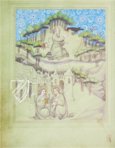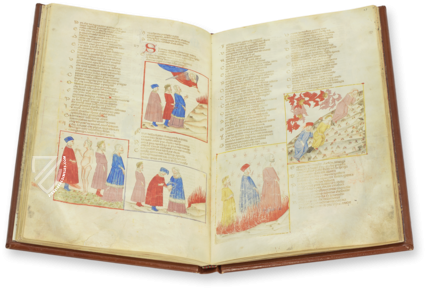Travels of Sir John of Mandeville
(3,000€ - 7,000€)
The Travels of Sir Jean de Mandeville was one of the most popular texts of the Middle Ages, written by an anonymous author. It is the travelogue of an English knight with the pseudonym Sir Jean de Mandeville, who traveled the East for 30 years before returning to Europe. This manuscript from the British Library is a particularly fine specimen of early 15th century Bohemian illumination. It presents the story entirely in pictures: the events are depicted in 28 full-page miniatures without text – such is the narrative power and artistry of these images, each an outstanding specimen of the grisaille technique. Created by the so-called Master of the Mandeville Travels, the miniatures are distinguished by intricately patterned backgrounds and figures with detail facial expressions. The image program is based on the Czech translation of the original French text by Vavrinec of Brezová from ca. 1410. An additional idiosyncrasy of the manuscript is its parchment, which was completely dyed green and thereby represents an absolute unicum.
Travels of Sir John Mandeville
An enchanting parchment manuscript with Gothic illumination from Bohemia originated during the first quarter of the 15th century. The knight John Mandeville’s 30-year-long adventure is illustrated by 28 full-page miniatures. These miniatures are unaccompanied by text, aside from a banner held by one of the figures in the miniature on f. 10, 'SPQR', and the image program is based on the Czech translation by Vavrinec of Brezová (ca. 1370 – ca. 1437), written c. 1410. This work of art originated from the hand of the so-called Master of the Mandeville Travels, known only by his name of convenience. An additional idiosyncrasy of the manuscript is its parchment, which was completely dyed green and thereby represents an absolute unicum.
Fascination with the Foreign
As fantastic as The Travels of Sir Jean de Mandeville sounded, the account was just as successful. Whoever was really behind the mysterious pseudonym of Jean de Mandeville, who presented himself as an English knight, remains contested to this day. In any case, he came world famous as the author of a compiled travelogue written in French between 1357 and 1371. In doing so, he not only made use of his own, presumably realistic experiences, but also numerous sources from historiography and literature, e.g. the Legenda Aurea by Jacobus de Voragine, the Rhabanus Maurus, or the Arthurian legend.
A Demi-Grisaille Masterpiece
Grisaille painting is a method that exclusively uses shades of grey or another neutral tone and is especially useful for depicting sculptures or as a model for engravers. Although seemingly less demanding than a full-color painting, the method can also serve to demonstrate the skill of a great master, or betray the hand of a less-talented assistant. Notable medieval practitioners include Jean Pucelle (ca. 1300–55), one of the greatest masters of 14th century France, whose Hours of Jeanne d'Evreux is an excellent example of the demi-grisaille technique that sparingly uses colors. The Master of the Mandeville Travels also makes sparing use of color, typically in the oft-patterned backgrounds or to emphasize important figures or objects. This allows him to focus on form and other details like facial expressions and garment folds, accounting for the surprisingly real and naturalistic aesthetic of these 28 miniatures. Furthermore, by utilizing parchment pages dyed with a delicate green, he was able to create a unique and refined work that can stand on its own without text.
Codicology
- Alternative Titles
- I Viaggi di Sir John Mandeville
Los Viajes de Sir John Mandeville
Die Reisen des Ritters John Mandeville - Size / Format
- 32 pages / 22.5 × 18.0 cm
- Origin
- Czech Republic
- Date
- Ca. 1410–1420
- Epochs
- Style
- Genre
- Language
- Illustrations
- 28 full-page miniatures
Travels of Sir John Mandeville
The Greek Mission of Pope John XXII
Enthroned in front of a lavish tapestry and wearing the golden papal tiara, the longest-reigning Avignon Pope receives a letter from a Greek emissary. The message from Emperor Andronikos III Palaiologos rejecting papal supremacy over the “Greek Church” and criticizing their pride and avarice provokes irritated and dissatisfied looks on the faces of John XXII and his cardinals. However, this popular anecdote is apocryphal and reflects widespread dissatisfaction with the Avignon Papacy.
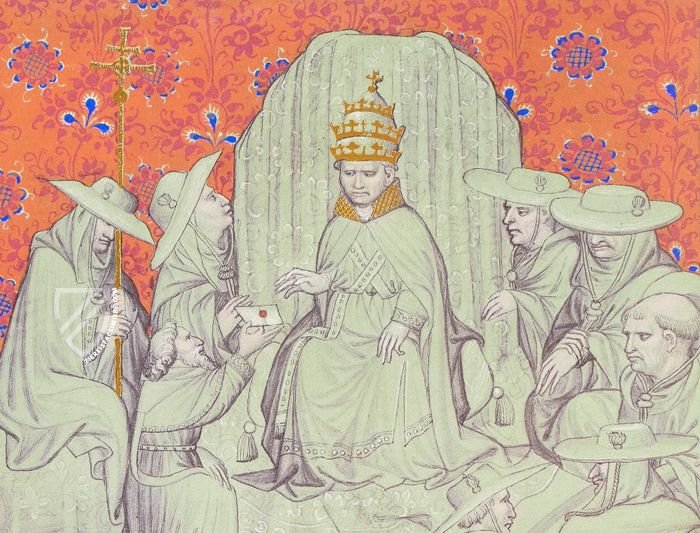
Travels of Sir John Mandeville
Traveling to Constantinople
Sir John Mandeville’s journey to the East initially took him through the kingdoms of Germany and Hungary to Constantinople. The first significant place he describes is the modern city of Sopron, Hungary, followed by Eisenberg Castle, the precise location of which is unknown. Although not described in the text, the artist has drawn large dragonflies buzzing along the riverbank.
Groups of travelers gesture vividly while discussing their route. As the protagonist, Mandeville is portrayed larger than the others and points to the gates of a city where the highways converge. He and his companions are also more sumptuously dressed to distinguish them. One of the figures depicted either crossing or sailing down the Danube River waves goodbye.

#1 Los Viajes de Sir John Mandeville
Language: Spanish
(3,000€ - 7,000€)
- Treatises / Secular Books
- Apocalypses / Beatus
- Astronomy / Astrology
- Bestiaries
- Bibles / Gospels
- Chronicles / History / Law
- Geography / Maps
- Saints' Lives
- Islam / Oriental
- Judaism / Hebrew
- Single Leaf Collections
- Leonardo da Vinci
- Literature / Poetry
- Liturgical Manuscripts
- Medicine / Botany / Alchemy
- Music
- Mythology / Prophecies
- Psalters
- Other Religious Books
- Games / Hunting
- Private Devotion Books
- Other Genres
- Afghanistan
- Armenia
- Austria
- Belgium
- Colombia
- Croatia
- Cyprus
- Czech Republic
- Denmark
- Egypt
- Ethiopia
- France
- Germany
- Greece
- Hungary
- India
- Iran
- Iraq
- Israel
- Italy
- Japan
- Lebanon
- Luxembourg
- Mexico
- Morocco
- Netherlands
- Palestine
- Peru
- Poland
- Portugal
- Russia
- Serbia
- Spain
- Sri Lanka
- Sweden
- Switzerland
- Syria
- Turkey
- Ukraine
- United Kingdom
- United States
- Uzbekistan
- Aboca Museum
- Ajuntament de Valencia
- Akademie Verlag
- Akademische Druck- u. Verlagsanstalt (ADEVA)
- Aldo Ausilio Editore - Bottega d’Erasmo
- Alecto Historical Editions
- Alkuin Verlag
- Almqvist & Wiksell
- Amilcare Pizzi
- Andreas & Andreas Verlagsbuchhandlung
- Archa 90
- Archiv Verlag
- Archivi Edizioni
- Arnold Verlag
- ARS
- Ars Magna
- ArtCodex
- AyN Ediciones
- Azimuth Editions
- Badenia Verlag
- Bärenreiter-Verlag
- Belser Verlag
- Belser Verlag / WK Wertkontor
- Benziger Verlag
- Bernardinum Wydawnictwo
- BiblioGemma
- Biblioteca Apostolica Vaticana (Vaticanstadt, Vaticanstadt)
- Bibliotheca Palatina Faksimile Verlag
- Bibliotheca Rara
- Boydell & Brewer
- Bramante Edizioni
- Bredius Genootschap
- Brepols Publishers
- British Library
- C. Weckesser
- Caixa Catalunya
- Canesi
- CAPSA, Ars Scriptoria
- Caratzas Brothers, Publishers
- Carus Verlag
- Casamassima Libri
- Chavane Verlag
- Christian Brandstätter Verlag
- Circulo Cientifico
- Club Bibliófilo Versol
- Club du Livre
- CM Editores
- Collegium Graphicum
- Collezione Apocrifa Da Vinci
- Comissão Nacional para as Comemorações dos Descobrimentos Portugueses
- Coron Verlag
- Corvina
- CTHS
- D. S. Brewer
- Damon
- De Agostini/UTET
- De Nederlandsche Boekhandel
- De Schutter
- Deuschle & Stemmle
- Deutscher Verlag für Kunstwissenschaft
- DIAMM
- Droz
- E. Schreiber Graphische Kunstanstalten
- Ediciones Boreal
- Ediciones Grial
- Ediclube
- Edições Inapa
- Edilan
- Editalia
- Edition Deuschle
- Edition Georg Popp
- Edition Leipzig
- Edition Libri Illustri
- Editiones Reales Sitios S. L.
- Éditions de l'Oiseau Lyre
- Editions Medicina Rara
- Editorial Casariego
- Editorial Mintzoa
- Editrice Antenore
- Editrice Velar
- Edizioni Edison
- Egeria, S.L.
- Eikon Editores
- Electa
- Emery Walker Limited
- Enciclopèdia Catalana
- Eos-Verlag
- Ephesus Publishing
- Ernst Battenberg
- Eugrammia Press
- Extraordinary Editions
- Fackelverlag
- Facsimila Art & Edition
- Facsimile Editions Ltd.
- Facsimilia Art & Edition Ebert KG
- Faksimile Verlag
- Feuermann Verlag
- Folger Shakespeare Library
- Franco Cosimo Panini Editore
- Friedrich Wittig Verlag
- Fundación Hullera Vasco-Leonesa
- G. Braziller
- Gabriele Mazzotta Editore
- Gebr. Mann Verlag
- Gesellschaft für graphische Industrie
- Getty Research Institute
- Giovanni Domenico de Rossi
- Giunti Editore
- Graffiti
- Grafica European Center of Fine Arts
- Guido Pressler
- Guillermo Blazquez
- Gustav Kiepenheuer
- H. N. Abrams
- Harrassowitz
- Helikon
- Hendrickson Publishers
- Henning Oppermann
- Herder Verlag
- Hes & De Graaf Publishers
- Hoepli
- Holbein-Verlag
- Hortus Deliciarum
- Houghton Library
- Hugo Schmidt Verlag
- Idion Verlag
- Il Bulino, edizioni d'arte
- ILte
- Imago
- Insel Verlag
- Instituto Nacional de Antropología e Historia
- Istituto dell'Enciclopedia Italiana - Treccani
- Istituto Ellenico di Studi Bizantini e Postbizantini
- Istituto Geografico De Agostini
- Istituto Poligrafico e Zecca dello Stato
- Italarte Art Establishments
- J. Thorbecke
- Jan Thorbecke Verlag
- Johnson Reprint Corporation
- Josef Stocker
- Josef Stocker-Schmid
- Jugoslavija
- Karl W. Hiersemann
- Kasper Straube
- Kaydeda Ediciones
- Kindler Verlag / Coron Verlag
- Kodansha International Ltd.
- Konrad Kölbl Verlag
- Kurt Wolff Verlag
- La Liberia dello Stato
- La Linea Editrice
- La Meta Editore
- Lambert Schneider
- Landeskreditbank Baden-Württemberg
- Leo S. Olschki
- Les Incunables
- Library of Congress
- Libreria Musicale Italiana
- Lichtdruck
- Lito Immagine Editore
- Lumen Artis
- Lund Humphries
- M. Moleiro Editor
- Maison des Sciences de l'homme et de la société de Poitiers
- Manuscriptum
- Martinus Nijhoff
- Maruzen-Yushodo Co. Ltd.
- MASA
- McGraw-Hill
- Militos
- Millennium Liber
- Müller & Schindler
- Nahar and Steimatzky
- National Library of Wales
- Neri Pozza
- Nova Charta
- Oceanum Verlag
- Odeon
- Orbis Mediaevalis
- Orbis Pictus
- Österreichische Staatsdruckerei
- Oxford University Press
- Pageant Books
- Parzellers Buchverlag
- Patrimonio Ediciones
- Pattloch Verlag
- PIAF
- Pieper Verlag
- Plon-Nourrit et cie
- Prestel Verlag
- Princeton University Press
- Prisma Verlag
- Priuli & Verlucca, editori
- Pro Sport Verlag
- Propyläen Verlag
- Pytheas Books
- Quaternio Verlag Luzern
- Reales Sitios
- Recht-Verlag
- Reichert Verlag
- Reichsdruckerei
- Riehn & Reusch
- Roberto Vattori Editore
- Rosenkilde and Bagger
- Roxburghe Club
- Salerno Editrice
- Sarajevo Svjetlost
- Schöck ArtPrint Kft.
- Scolar Press
- Scrinium
- Scripta Maneant
- Scriptorium
- Siloé, arte y bibliofilia
- SISMEL - Edizioni del Galluzzo
- Sociedad Mexicana de Antropología
- Société des Bibliophiles & Iconophiles de Belgique
- Soncin Publishing
- Sorli Ediciones
- Stainer and Bell
- Studer
- Styria Verlag
- Sumptibus Pragopress
- Szegedi Tudomànyegyetem
- Taberna Libraria
- Tarshish Books
- Taschen
- Tempus Libri
- Testimonio Compañía Editorial
- Thames and Hudson
- The Clear Vue Publishing Partnership Limited
- The Facsimile Codex
- The Folio Society
- The Marquess of Normanby
- The Richard III and Yorkist History Trust
- Tip.Le.Co
- TouchArt
- TREC Publishing House
- TRI Publishing Co.
- Trident Editore
- Typis Regiae Officinae Polygraphicae
- Union Verlag Berlin
- Universidad de Granada
- University of California Press
- University of Chicago Press
- Urs Graf
- Vallecchi
- Van Wijnen
- VCH, Acta Humaniora
- VDI Verlag
- VEB Deutscher Verlag für Musik
- Verlag Anton Pustet / Andreas Verlag
- Verlag Bibliophile Drucke Josef Stocker
- Verlag der Münchner Drucke
- Verlag für Regionalgeschichte
- Verlag Styria
- Vicent Garcia Editores
- W. Turnowsky
- Waanders Printers
- Wiener Mechitharisten-Congregation (Wien, Österreich)
- Wissenschaftliche Buchgesellschaft
- Wydawnictwo Dolnoslaskie
- Xuntanza Editorial
- Zakład Narodowy
- Zollikofer AG

